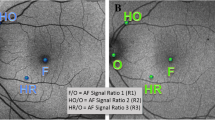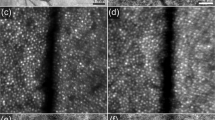Abstract
The aims of this study are to generate subtraction images of blue-light autofluorescence (BL-AF) and near-infrared autofluorescence (NIR-AF) from normal eyes, eyes with full thickness macular holes, and eyes with irregular foveal contour, and to compare their autofluorescence patterns. This retrospective study included 44 normal eyes of 22 health individuals, 32 eyes with full thickness macular holes of 32 patients, and 36 eyes with irregular foveal contour of 36 patients. BL-AF and NIR-AF were obtained from all patients and used to generate subtraction images using the Image J software. The decreased signal of central patch was recorded. The central foveal thickness (CFT) and outer nucleus layer (ONL) thickness of fovea were measured to calculate the ONL thickness/CFT ratio. The subtraction images showed regularly increased signal in the central macula of all normal eyes. In contrast, decreased signal of central patch was detected in all full thickness macular holes eyes and 26 out of 36 eyes with irregular foveal contour. No significant difference of the ONL thickness/CFT ratio (F = 2.32, P = 0.113) was observed between normal and irregular foveal contour eyes with or without decreased signal of central patch. Both regularly increased signal and decreased signal of central patch were detected in the eyes with irregular foveal contour. Our results suggest that subtraction images are useful for the assessment of certain macular conditions by providing supplementary information to the green-light autofluorescence and BL-AF.


Similar content being viewed by others
References
Hassenstein A, Meyer CH (2009) Clinical use and research applications of Heidelberg retinal angiography and spectral domain optical coherence tomography—a review. Clin Exp Ophthalmol 37:130–143
Delori FC, Fleckner MR, Goger DG, Weiter JJ, Dorey CK (2000) Autofluorescence distribution associated with drusen in age-related macular degeneration. Invest Ophthalmol Vis Sci 41(2):496–504
Dorey CK, Wu G, Ebenstein D, Garsd A, Weiter JJ (1989) Cell loss in the aging retina. Relationship to lipofuscin accumulation and macular degeneration. Invest Ophthalmol Vis Sci 30(8):1691–1699
Delori FC, Dorey CK, Staurenghi G, Arend O, Goger DG, Weiter JJ (1995) In vivo fluorescence of the ocular fundus exhibits retinal pigment epithelium lipofuscin characteristics. Invest Ophthalmol Vis Sci 36(3):718–729
Schmitz-Valckenberg S, Holz FG, Bird AC, Spaide RF (2008) Fundus autofluorescence imaging: review and perspectives. Retina 28:385–409
Reinboth J, Gautschi K, Munz K, Eldred GE, Remé CE (1997) Lipofuscin in the retina: quantitative assay for an unprecedented autofluorescent compound (pyridinium bis-retinoid, A2-E) of ocular age pigment. Exp Eye Res 65:639–643
Keilhauer CN, Delori FC (2006) Near-infrared autofluorescence imaging of the fundus: visualization of ocular melanin. Invest Ophthalmol Vis Sci 47:3556–3564
Spaide RF, Klancnik JM Jr (2005) Fundus autofluorescence and central serous chorioretinopathy. Ophthalmology 112:825–833
Snodderly DM, Auran JD, Delori FC (1984) The macularpigment.II. Spatial distribution in primate retinas. Invest Ophthalmol Vis Sci 25:674–685
Trieschmann M, van Kuijk FJ, Alexander R, Hermans P, Luthert P, Bird AC et al (2008) Macular pigment in the human retina: histological evaluation of localization and distribution. Eye 22:132–137
Weiter JJ, Delori FC, Wing G, Fitch KA (1986) Retinal pigment epithelial lipofuscin and melanin and choroidal melanin in human eyes. Invest Ophthalmol Vis Sci 27:145–152
12.Gabel V-P, Birngruber R, Hillenkamp F. (1978) Visible and near infrared light absorption in pigment epithelium and choroid. In: Shimuzu K, OsterhuisJAs, eds. XXIII Conrilium Ophthalmol Kyoto, Exerpta Medica. Amsterdam: Oxford 658–662.
Feeney-Burns L, Berman ER, Rothman H (1980) Lipofuscin of human retinal pigment epithelium. Am J Ophthalmol 90:783–791
Kayatz P, Thumann G, Luther TT et al (2001) Oxidation causes melanin fluorescence. Invest Ophthalmol Vis Sci 42:241–246
Yin D (1996) Biochemical basis of lipofuscin, ceroid, and age pigmentlike fluorophores. Free Radic Biol Med 21:871–888
Keilhauer CN, Delori FC (2006) Near-infrared autofluorescence imaging of the fundus: visualization of ocular melanin. Invest Ophthalmol Vis Sci 47(8):3556–3564
Feeney L (1978) Lipofuscin and melanin of human retinal pigment epithelium. Fluorescence, enzyme cytochemical, and ultrastructural studies. Invest Ophthalmol Vis Sci 17:583–600
Duncker T, Tabacaru MR, Lee W, Tsang SH, Sparrow JR, Greenstein VC (2013) Comparison of near-infrared and short-wavelength autofluorescence in retinitis pigmentosa. Invest Ophthalmol Vis Sci 54(1):585–591
Solbach U, Keilhauer C, Knabben H, Wolf S (1997) Imaging of retinal autofluorescence in patients with age-related macular degeneration. Retina 17:385–389
Sarks JP, Sarks SH, Killingsworth MC (1988) Evolution of geographic atrophy of the retinal pigment epithelium. Eye 2:552–577
Schraermeyer U, Heimann K (1999) Current understanding on the role of retinal pigment epithelium and its pigmentation. Pigment Cell Res 12:219–236
Barnett G, Schofield C, Gershlick A (2014) 74 Pro-angiogenic effects of the prolyl-hydroxylase inhibitor FG-2216/BIQ: therapeutic angiogenesis for the treatment of chronic total occlusions. Heart 100(3):A43–44
Mu H, Lin KX, Zhao H, Xing S, Li C, Liu F, Lu HZ, Zhang Z, Sun YL, Yan XY, Cai JQ, Zhao XH (2014) Identification of biomarkers for hepatocellular carcinoma by semiquantitative immunocytochemistry. World J Gastroenterol 20(19):5826–5838
Yoshida Y, Sakamoto M, Maeda E, Ohtsu H, Ota S, Asamura H, Nakajima J.Can Image Analysis on High-Resolution Computed Tomography Predict Non-Invasive Growth in Adenocarcinoma of the Lung?Ann Thorac Cardiovasc Surg. 2014 Apr 18. [Epub ahead of print]
Hendrickx RP1, de Leeuw PA, Golano P, van Dijk CN, Kerkhoffs GM. Safety and efficiency of posterior arthroscopic ankle arthrodesis. Knee Surg Sports Traumatol Arthrosc. 2014 May 8. [Epub ahead of print]
Degli Esposti S, Egan C, Bunce C, Moreland JD, Bird AC, Robson AG (2012) Macular pigment parameters in patients with macular telangiectasia (MacTel) and normal subjects: implications of a novel analysis. Invest Ophthalmol Vis Sci 53(10):6568–6575
Eldred GE, Katz ML (1988) Fluorophores of the human retinal pigment epithelium: separation and spectral characterization. Exp Eye Res 47:71–86
Benson R, Meyer R, Zaruba M, McKhann G (1979) Cellular autofluorescence: is it due to flavins? J Histochem Cytochem 27:44–48
30.Richards-Kortum RR. (1987) Fluorescence spectroscopy as a technique for diagnosis of pathologic conditions in human arterial, urinary bladder, and gastro-intestinal tissues. Cambridge: Massachusetts Institute of Technology PhD thesis.
Schomaker KT, Frisoli JK, Compton CC et al (1992) Ultraviolet laser induced fluorescence of colonic tissue: basic biology and diagnostic potential. Lasers Surg Med 12:63–78
Gaudric A, Aloulou Y, Tadayoni R, Massin P (2013) Macular pseudoholes with lamellar cleavage of their edge remain pseudoholes. Am J Ophthalmol 155(4):733–742
Acknowledgments
We thank Dr. Yuedong Hu and Prof. Na Cai for the assistance with diagnoses, treatment, and follow-up in the Department of Ophthalmology at the First Hospital of China Medical University. In addition, we thank Prof. Steffen Schmitz-Valckenberg and Frank Holz in the Department of Ophthalmology, University of Bonn for the instruction on NIR-AF and subtraction images.
Funding
This study was supported by the Liaoning Science and Technology Project (Project #: 2011225014). The funders had no role in study design, data collection and analysis, decision to publish, and preparation of the manuscript.
Author information
Authors and Affiliations
Corresponding authors
Rights and permissions
About this article
Cite this article
Hua, R., Gangwani, R., Liu, L. et al. Use digital subtraction images of blue-light and near-infrared autofluorescence for the assessment of irregular foveal contour. Lasers Med Sci 30, 445–451 (2015). https://doi.org/10.1007/s10103-014-1693-2
Received:
Accepted:
Published:
Issue Date:
DOI: https://doi.org/10.1007/s10103-014-1693-2




